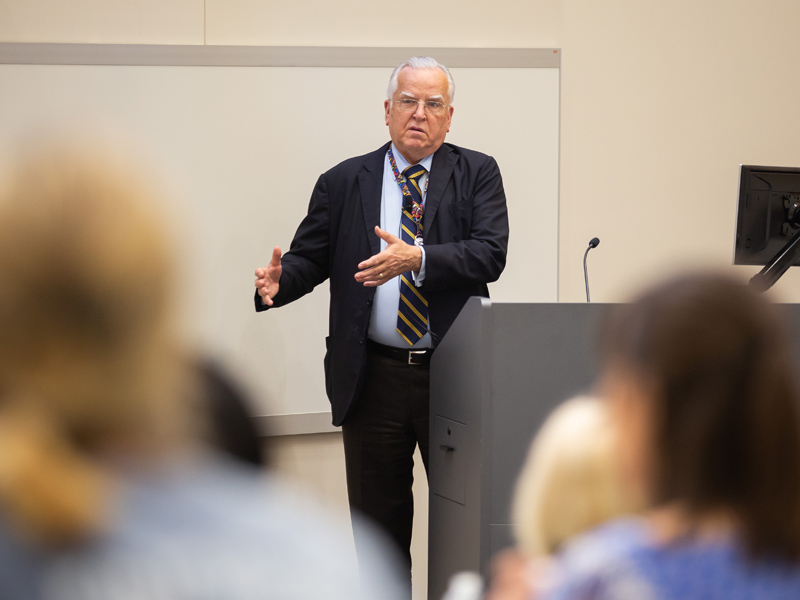Vatican Conference ignites UMMC Cancer Institute director’s medical imagination

An invitation to the Fourth International Vatican Conference put Dr. John Ruckdeschel in the company of men and women from varied backgrounds, all focused on making the world healthier.
Ruckdeschel, director of the University of Mississippi Medical Center Cancer Institute, was among about 300 invited to the conference.

“(The Vatican Conference) brings together a mix of academics and entrepreneur types from businesses, interdigitating them in the conversation and overlaying them with people from spiritual and religious persuasions and people who have a philosophical approach and people who are confronting the ‘Wait a minute, if we do that, does it mean this or that down the line?’” Ruckdeschel said. “These are groups of people who don’t usually get together. It’s not some guy who came in, gave a talk and left. We were locked in a conference center for three days.
“There was this cross-fertilization that you usually don’t get.”
The conference, which takes place every other year in Rome, explored “How Science, Technology and the 21st Century Medicine Will Impact Culture and Society.” It was sponsored by the Vatican, the Cura Foundation, the STOQ Foundation and the Stem for Life Foundation.
Ruckdeschel said major points discussed during the conference included:
Regenerative medicine
“Research is showing us that cells, not pills, may be the pharmacy of the future,” he said. “Currently, UMMC has no major research effort on using stem cells in joint repair, rotator cuff diseases, interstitial lung disease, to reduce rejection after lung transplant, to aid in multiple sclerosis, cerebral palsy or other diseases.”
Gene therapy
Gene therapy also offers hope for about 6,000 diseases with a molecular basis.
“In several cases today, we can take a human gene, edit it and return it to your body and potentially cure your disease,” Ruckdeschel said. “These therapies are growing rapidly and bring hope in rare cancers and other diseases. We have to watch for unintended consequences and use the knowledge ethically.”

One unintended consequence discussed centered on the probable ability to one day cure sickle cell disease with gene editing or gene therapy.
“If you have sickle cell trait, you don’t get malaria, and if you’re in a malaria-infested part of the world, that’s important,” he said.
The same knowledge would allow the mutating of mosquitos that carry malaria so they cannot reproduce, but no one can yet define what else mosquitos do in that environment.
“Those of us who brought kudzu to control erosion know only too well the risk of unintended consequences,” Ruckdeschel said.
Inflammation
Conference attendees discussed the premise that inflammation is the root of chronic diseases. Atherosclerosis, lung cancer and autoimmune disease already are strongly related to chronic inflammation.
“A researcher from the University of Alabama at Birmingham had fascinating maps that showed where the autoimmune diseases are in the country,” Ruckdeschel said. “Where are the biggest clusters of lupus, arthritis, etc.? In the Southeast. It’s a big black spot on the map and drifts off into little clusters.
“If you superimpose the maps for cancer, for heart disease, you see the same thing. But if you go to Denver and look up all the lupus patients, there’s no correlation with cancer or heart disease. That correlation only exists in the Southeast. Is that something in the environment? Is it genetic?”
Other cities with high African-American populations, like Detroit or Los Angeles, do not have those correlations.

Ruckdeschel said some speakers, such as Pope Francis I and Francis Collins, director of the National Institutes of Health, left lasting impressions.
The Pope emphasized “just because we can do something doesn’t mean we should do something.” Most of those attending the forum, for example, didn’t think science should be used to choose a child’s hair or eye color or even the child’s height. “But it might not be a negative to folks who want kids with blonde hair or a higher IQ,” Ruckdeschel said.
The Pope also said, “If we’re going to do it, it must be available in relative short order to anyone who needs it, not just the wealthy.”
Collins, who led the Human Genome Project, talked about mapping the human genome and the complexities involved in it.
“He’s committed to his last cell to advancing the science and making sure it’s done right,” Ruckdeschel said.
Ruckdeschel’s lasting impression?
“One thing from this conference is the extraordinary enthusiasm and the myriad opportunities that exist to make substantive changes in multiple diseases,” he said. “With all the spinoffs that may go to the negative side, we’re still getting after diseases we’ve never even been able to dream about treating, like MS.”



